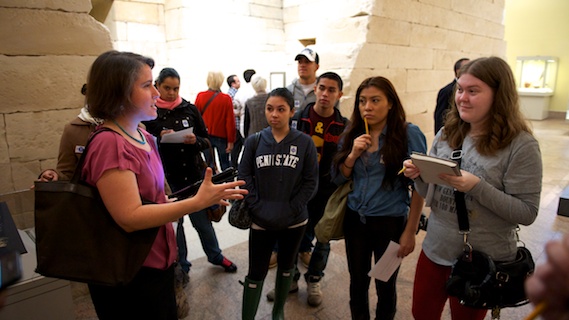
Assistant Professor of Art History Megan O’Neil has such an affinity for Mayan Art she’s been on archeological excursions to Mexico, Guatemala, and Belize.
“So many artifacts have been destroyed over time,” she says, “but we can better understand their culture through their artwork.”
Recently, O’Neil was offered the chance to contribute to a scholarly publication called Ancient Maya Art at Dumbarton Oaks. (Dumbarton Oaks is a Washington, D.C.-based research library and museum affiliated with Harvard University that houses Mayan artwork predominantly found in the mid-twentieth century.)
O’Neil immediately accepted the project, and along with other scholars, contributed content to the book.
The result—and proof that hard work pays off? Ancient Maya Art at Dumbarton Oaks won the 2013 Alfred H. Barr Award for small museums from the College Art Association.
Established in 1980, the Alfred H. Barr Jr. award is presented to the author or authors of an especially distinguished catalogue in the history of art, published in the English language under the auspices of a museum, library, or collection.
The book, described by Dumbarton Oaks as “a volume that provides a detailed introduction to Maya art and culture,” is presented in catalogue format, and written by leading international scholars of Maya archaeology, art history, and writing.
Writing about Jaina figurines
“The first-third of the book is the history of the collection, ceramics, shells, kinds of materials and objects in the collection,” explains O’Neil. “My contribution is about Jaina-style figurines; followed by the section on individual objects. I have essays on 9 objects in the collection.”
Jaina refers an island located in the waters of the Gulf of Mexico, off the western coast of the State of Campeche, Mexico.
“Although often called ‘Jaina’ figurines, we use the term ‘Jaina-style’ or ‘Jaina tradition’ to refer to the ceramic figurines in the Dumbarton Oaks collection, for there is no certainty that they were found on the Island of Jaina,” explains O’Neil.
According to O’Neil, Jaina sculptures “portray many different kinds of figures in diverse roles of activities—men of different professions (including rulers, ballplayers, court attendants, and captives) and women of different statuses who are shown sitting nobly or engaging in activities such as weaving, cooking, or holding children,” she states, adding, “They give us windows into different kinds of people and activities in the ancient Maya culture.”
Other works
O’Neil, a New Orleans native who attended Yale, then the University of Texas at Austin for her Master’s, and returned to Yale for her PhD in art history, also completed a post-doctorate fellowship at the Center for Advanced Study in the Visual Arts at the National Gallery of Art and has been published in other journals such as RES: Anthropology and Aesthetics, Ancient Mesoamerica, the Journal of Visual Culture, and more.
“At BMCC, I’m currently teaching Intro to Art History classes and Intro to Western Art, and Teaching Mayan Art in the Non-Western Art History class,” she says, adding, “I’m also in the process of developing a new class on ancient arts of Mexico, Central, America, and South America and working on a book titled The Lives of Ancient Maya Sculptures.”
EDITOR’S NOTE: According to O’Neil, “there is no difference between ‘Maya art’ or ‘Mayan art.’ There is a convention among scholars to write ‘Maya art,’ but most people outside of scholarship say ‘Mayan art.'”
STORY HIGHLIGHTS
- Contributed content about Jaina figurines to museum book
- Teaches art history at BMCC.

